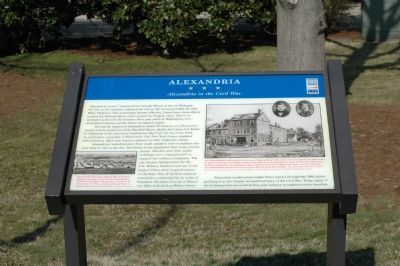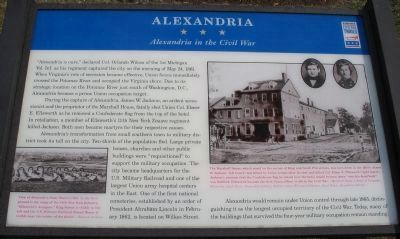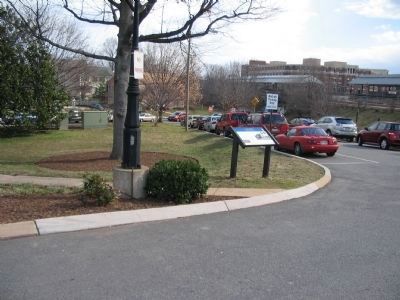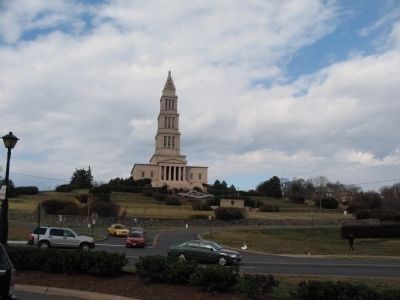Taylor Run in Alexandria, Virginia — The American South (Mid-Atlantic)
Alexandria
Alexandria in the Civil War
During the capture of Alexandria, James W. Jackson, an ardent secessionist and the proprietor of Marshall House, fatally shot Union Col. Elmer E. Ellsworth as he removed a Confederate flag from the top of the hotel. In retaliation, a member of Ellsworth's 11th New York Zouave regiment killed Jackson. Both men became martyrs for their respective causes.
Alexandria's transformation from small southern town to military district took its toll on the city. Two-thirds of the population fled. Large private homes, churches and other public buildings were "requisitioned" to support the military occupation. The city became headquarters for the U.S. Military Railroad and one of the largest Union army hospital centers in the East. One of the first national cemeteries, established by an order of President Abraham Lincoln in February 1862, is located on Wilkes Street.
Alexandria would remain under Union control through late 1865, distinguishing it as the longest occupied territory of the Civil War. Today, many of the buildings that survived the four-year military occupation remain standing.
Erected by Virginia Civil War Trails.
Topics and series. This historical marker is listed in this topic list: War, US Civil. In addition, it is included in the Virginia Civil War Trails series list. A significant historical month for this entry is February 1862.
Location. This marker has been replaced by another marker nearby. It was located near 38° 48.401′ N, 77° 3.741′ W. Marker was in Alexandria, Virginia. It was in Taylor Run. Marker was at the intersection of Callahan Drive and King Street (Virginia Route 7), on the right when traveling north on Callahan Drive. Marker is in front of the Amtrak Station. Touch for map. Marker was at or near this postal address: 110 Callahan Drive, Alexandria VA 22301, United States of America. Touch for directions.
Other nearby markers. At least 5 other markers are within walking distance of this location. Alexandria in the Civil War (here, next to this marker); Veterans Memorial (a few steps from this marker); Alexandria War Memorial (a few steps from this marker); World War I Memorial (a few steps from this marker); All Aboard at Alexandria Union Station (within shouting distance of this marker). Touch for a list and map of all markers in Alexandria.
More about this marker. On the lower left is a wartime photo showing a View of Alexandria from Shuter's Hill. In the foreground is the camp of the 44th New York Infantry, "Ellsworth's Avengers." King Street is visible to the left and the U.S. Military Railroad Round House is visible near the center of the photo. (Photo credited to the National Archives.)
On the right is a photo of The Marshall House, which stood on the corner of King and South Pitt streets, was torn down in the 1950s. James W. Jackson (left insert) was killed by Union troops after he shot and killed Col. Elmer E. Ellsworth (right insert). Jackson's promise that the Confederate flag he raised over the hotel would be torn down "over his dead body" was fulfilled. Ellsworth became the first Union officer to die in the Civil War. (Photo of the Marshall House credited to the Library of Congress. Portrait of Ellsworth credited to Lloyd House, Alexandria Library. Portrait of Jackson from Ames Williams Collection, Lloyd House, Alexandria Library.)
Also see . . . Notes and Images from the Civil War Occupation of Alexandria. from the diary of Henry B. Whittington. Project mounted by the Alexandria Library. (Submitted on March 12, 2006.)
Credits. This page was last revised on January 28, 2023. It was originally submitted on March 12, 2006, by Tom Fuchs of Greenbelt, Maryland. This page has been viewed 7,938 times since then and 30 times this year. Photos: 1. submitted on March 12, 2006, by Tom Fuchs of Greenbelt, Maryland. 2, 3, 4. submitted on March 1, 2008, by Craig Swain of Leesburg, Virginia. • J. J. Prats was the editor who published this page.



